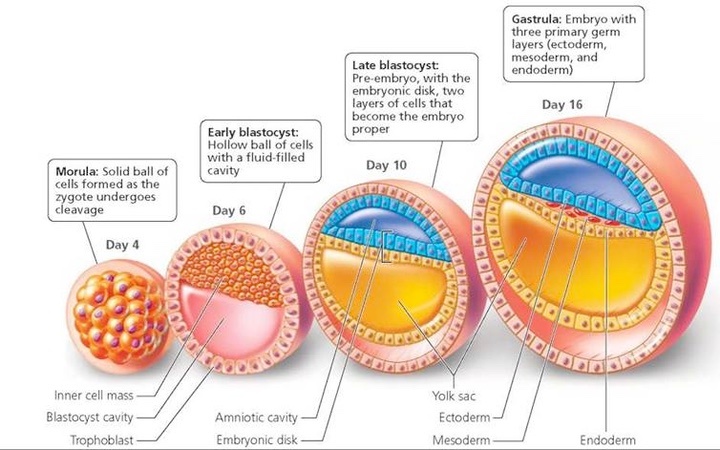According to modern science, before I was a baby, I was an embryo. And before that, I was a zygote.
I have no memory of these experiences. So I have to trust modern science.
In my case, the transition from zygote to embryo took place inside one of my mother’s two Fallopian tubes. (No one knows which one. And it’s not really that important.)
If I was a typical zygote, which I assume to be the case, I was officially promoted to ’embryo’ after growing for a couple of weeks in my mom’s belly. At this point, modern science tells us, I looked like a tiny pink ball of cells.

But apparently, the transition from zygote to embryo does not always take place in someone’s Fallopian tubes. Thanks to modern science, the transition now occasionally takes in a test tube. At which point, the embryo is likely to be intentionally frozen. For safe keeping, so to speak.
But not entirely safe.
This situation — frozen embryos in test tubes — posed a problem to seven justices sitting on the Alabama Supreme Court last week. Six of them agreed that embryos, in a test tube, qualified as children, and as such, were protected by the Wrongful Death of a Minor Act, passed by the Alabama legislature in 1872.
Emily and James Le Page, “parents and next friends of two decreased embryos, Embryo A and Embryo B,” had sued the Center for Reproductive Medicine over the alleged death of Embryo A and B, which the Center had been keeping in a test tube on behalf of the Le Page parents. The Le Page parents were not “parents” in the normal sense of the word. In fact, they were having trouble conceiving a child (for reasons I am not privy to) and they had enlisted the help of the Center to eventually implant a test tube embryo in Ms. Le Page’s uterus.
The frozen children had been kept in a ‘cryogenic nursery’ where, reportedly, a frozen embryo can remain ‘viable’ for several decades, possibly longer. No one actually knows how long you can keep a child frozen, I guess.
The cryogenic nursery was located inside a hospital in Mobile.
From the Supreme Court ruling:
The plaintiffs allege that the Center was obligated to keep the cryogenic nursery secured and monitored at all times. But in December 202, a patient at the Hospital managed to wander into the Center’s fertility clinic through an unsecured doorway. The patient then entered the cryogenic nursery and removed several embryos.
The subzero temperatures at which the embryos had been frozen ‘freeze-burned’ the patient’s hands, causing the patient to drop the test tubes on the floor.
With unhappy results.
You can read the full Court ruling here.
A lower Alabama court had determined that the Center and Hospital were not liable under the 1872 Wrongful Death of a Minor Act. The lower court didn’t consider a frozen embryo stored in a test tube to qualify as a “minor child”.
The Le Page parents were joined in the Supreme Court appeal by two additional couples — William and Caroline Fonde, and Scott Aysenne and Felicia Burdick-Aysenne — who had also had their embryo test tubes dropped, unfortunately, on the floor.
The original lawsuits had asked for compensatory damages. The trial court dismissed those claims, with the reasoning that a frozen embryo in a test tube was not a “child”. But the Supreme Court had other ideas.
We cannot blame the plaintiffs for being unhappy about the lack of security at the Center, or for suffering emotional pain over their loss.
One question here is whether a frozen embryo in a test tube in a cryogenic nursery is a “child” — when the law cited by the plaintiffs was written in 1872.
The Alabama Supreme Court answered that question with a tentative, “Yes”. (With one of the seven justices dissenting.)
That ruling sent the cases back to a lower court, to determine whether compensatory damages can be awarded.
This poses an interesting situation for cryogenic nurseries. Typically, the process for “in vitro fertilization” (IVF) — where the mother’s eggs and the father’s sperm are stirred together — creates a large number of embryos… more children than the parents would ever consider raising. But because this is an unnatural way to fertilize and implant potential babies, multiple embryos are often needed to produce a single live birth.
Between 1991 and 2012 in the U.K. — according to the Center for Genetics and Society — more than 3.5 million human embryos were created. Fewer than 10% were successfully implanted to produce babies. Almost 840,000 were put into storage for future use, and more than 2,000 were stored for donation. About 5,900 were set aside for scientific research.
(We all know what “scientific research” likely means to a frozen child.)
That leaves about 1.7 million embryos unaccounted for, in the U.K.
If that same ratio,of successful births compared to embryos created holds here in the U.S. — where, according to CNN, we’ve had about 8 million successful IVF births — it’s possible that 23 million frozen embryonic children are sitting in cryogenic nurseries, and 80 million embryos have gone missing.
Those are merely guesses. I wasn’t able to find actual numbers for the U.S.
Or for Alabama.
UC Davis Professor of Law Mary Ziegler, quoted on NPR:
“…if Alabama IVF providers feel obligated to implant every embryo they create, that’s likely to both reduce the chances that any IVF cycle will be successful. It also might make it a lot more expensive. IVF is already very expensive. I think the average being between about $15,000 and $20,000 per IVF cycle. Many patients don’t succeed with IVF after one cycle. But if you were not allowed to create more than one embryo per cycle, that’s likely to make IVF even more financially out of reach for people who don’t have insurance coverage, and who struggle to pay that hefty price tag.”
Another quote, this time from journalist Alexandra Petri in the Washington Post:
Three Alabama clinics that perform IVF have already halted it out of fear of legal repercussions. Would-be parents who had been planning the process in the hopes of meeting their children someday have been forced to abandon that hope. In the name of protecting unborn children! Not children, as you and I understand them — the kind of children who shriek with delight when you blow raspberries on their bellies, who need their diapers changed and have a favorite bear. The better kind, in the eyes of these judges. The kind that will never get to be born.

